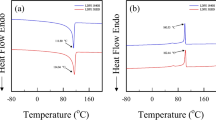Abstract
Two kinds of cross-linked urethane methacrylate resins have been investigated using three-point bend tests to determine their environmental stress cracking (ESC) behaviour in a range of liquids (water, sodium hydroxide, ethylene glycol, acetonitrile, acetic acid, acetone, tetrahydrofuran, toluene, 3,5,5-trimethylhexanol and petrol). The resins were found to undergo ESC in organic liquids only, and the critical strains, ɛc, and critical stresses, σc, have been related to the solubility parameters, δ, of the liquid environments. The most severe ESC was observed in solvents with δ−19–20 MPa1/2, corresponding to minimum points in the plots of ɛc and σc against δ. Generally, the resin with the higher cross-link density had a greater resistance to ESC, but the effect of liquid diffusion complicated the situation and was found to play an important role in the ESC behaviour of these materials. The results confirmed that liquid diffusion into the resins lowered the critical strain (and stress), leading to earlier failure. In the case of the lower cross-link density resin, very fast diffusion was found to cause softening. However, it was noted that liquid diffusion can also blunt crazes and cracks.
Similar content being viewed by others
References
E. J. Kramer, in “Developments in Polymer Fracture”, edited by E. H. Andrews (Applied Science, London, 1979) p. 55.
R. J. Young, “Introduction to Polymers” (Chapman and Hall, London, 1983) p. 314.
G. A. Bernier and R. P. Kambour, Macromolecules 1 (1968) 393.
P. I. Vincent and S. Raha, Polymer 13 (1972) 283.
A. J. Kinloch and R. J. Young, “Fracture Behaviour of Polymers” (Applied Science, London, 1983).
M. L. Orton, I. M. Fraser and S. H. Rogers, Eng. Plast. 1 (1988) 274.
M. L. Orton and D. J. Sparrow, Cell. Polym. 7 (1988) 309.
A. F. M. Barton, “CRC Handbook of Solubility Parameters and Other Cohesion Parameters” (CRC Press, Boca Raton, 1983).
S. Petrie, A. T. Dibenedetto and J. Miltz, J. Mater. Sci. 14 (1979) 246.
J. Miltz, A. T. Dibenedetto and S. Petrie, ibid. 13 (1978) 2037.
S. Yamini and R. J. Young, ibid. 14 (1979) 1609.
R. P. Kambour and R. E. Robertson, in “Polymer Science”, edited by A. D. Jenkins (North-Holland, Amsterdam, 1972) p. 814.
P. J. Burchill, G. Mathys and R. H. Stacewicz, J. Mater. Sci. 22 (1987) 483.
Author information
Authors and Affiliations
Rights and permissions
About this article
Cite this article
Li, J., Arnold, J.C. & Isaac, D.H. Environmental stress cracking behaviour of urethane methacrylate based resins. JOURNAL OF MATERIALS SCIENCE 29, 3095–3101 (1994). https://doi.org/10.1007/BF00356650
Received:
Accepted:
Published:
Issue Date:
DOI: https://doi.org/10.1007/BF00356650




